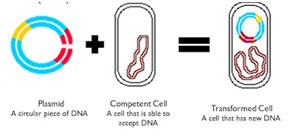Definition
The genetic recombination in which bacteria absorbs naked DNA is called transformation. Transformation is the genetic alteration of a cell resulting from the introduction, uptake, and expression of foreign genetic material (DNA or RNA).
Discovery of Transformation
Fredrick Griffith was a British microbiologist. He provided the first evidence that DNA is the hereditary material. He performed experiments on pathogenic bacteria Streptococcus pneomoniae.
There are two forms of S.pneomoniae:
Normal form or S-form (smooth): Normal pathogenic form of this bacterium forms smooth colonies on a culture dish. So, it is called S form. They are virulent.
Mutant form or R- form (rough):
The mutant forms lack an enzyme that manufactures the polysaccharide coat. They form rough colonies so they are called R form. they are non-virulent.
Experiments of Griffith
He performed the following experiments.
- First of all, Griffith infected the mice with S strain of pneomoniae bacteria. The mice died of blood poisoning.
- He then infected the mice with R strain pneomoniae bacteria. These bacteria lack polysaccharide coats. As they are not virulent so the mice did not become ill. Thus, its outer coat is necessary for virulence.
- He wanted to know whether the polysaccharide coat itself had a toxic effect. He injected a dead S strain of bacteria into the mice. The mice remained healthy. This shows that the coat itself has no toxic effect.

- Now he injected mice with a mixture containing dead S bacteria and live coatless R bacteria. Both of these strains are themselves harmless. But the mice developed the disease symptoms and many of them died.
The blood of the dead mice contained a large number of live virulent S bacteria. These bacteria had surface proteins of life previously said R strain.
- Thus, the information of polysaccharide coat has passed from the dead S bacteria to the live R bacteria in the mixture. It permanently transforms the coatless R bacteria into the virulent S variety.
This is what is known as transformation. The transfer of genetic material from one cell to another and altering the genetic makeup of the recipient cell is called transformation.
Mechanism of Transformation
The ability of bacteria to take up foreign DNA is called competence. There are two different forms of competence.
Natural Competence
Natural bacterial transformation occurs only in bacterial species having natural competence. Such species carry sets of genes specifying machinery. It brings DNA across the cell’s membrane or membranes.
The evolutionary function of these genes is controversial. It is believed that cells take up DNA to acquire new versions of genes. According to natural competence, cells take up DNA mainly as a source of nucleotides.
- Natural transformation is very efficient for linear molecules like fragments of chromosomal DNA but it is not used for the transfer of circular plasmid DNAs.
Artificial Competence
It is not encoded in the cell’s genes. Instead, it is a laboratory procedure. In this procedure, the cells are passively made permeable to DNA. These procedures are comparatively easy and simple. It can be used to genetically engineer bacteria.
Methods of Artificial Competence
- Chilling and heat shocking
The cells are chilled in the presence of divalent cations like CaCl2. It makes the cell wall permeable to plasmid DNA. Cells are incubated with the DNA and then briefly heat shocked. It causes the DNA to enter the cell.
This method works well for circular plasmid DNAs but it is not used for linear molecules like fragments of chromosomal DNA.
- Electroporation
It is another way to make holes in cells. In this method, cells are briefly shocked with an electric field of 100- 200 V. Now plasmid DNA can enter the cell through these holes. Natural membrane repair mechanisms will close these holes, afterward.

